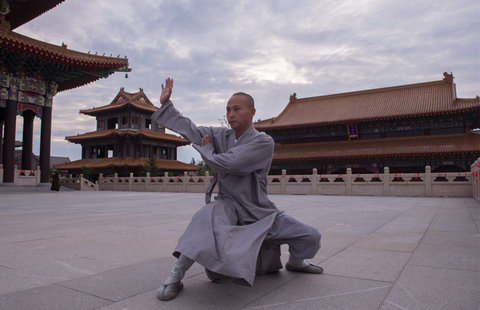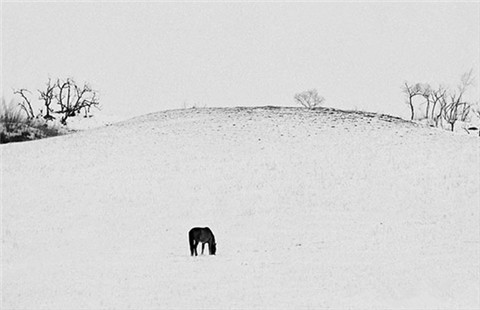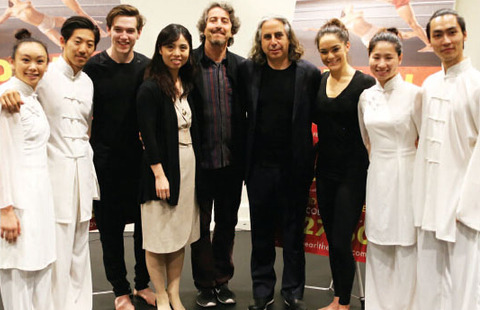Abstract artist Xu Dongdong
Updated: 2015-07-29 12:14
(China Today)
|
||||||||
Talking with Xu Dongdong is a pleasure. His gentle voice with its authentic Beijing burr is easy on the ear. Occasionally laughing out loud, he reveals a frank and free personality.
Our topics of discussion ranged from the arts and philosophy to quantum mechanics, from traditional Oriental culture to the industrial revolution in the West, and from his early years in painting studies to the Chinese-style abstract paintings that he now creates. His personal experiences represent a reflection on life by an artist who has a wild imagination and a free spirit.
A Thinking Painter
Xu Dongdong was born to a scholarly Beijing family in 1959. His grandfather Xu Songming was the president of five universities successively. His father was a railway engineer and his mother was a doctor. In Xu's family, sons were expected to study science and engineering and daughters to take up medicine. For Xu Dongdong, however, neither subject was interesting.
"A painting of geese by prominent artist Xu Beihong and works by the renowned calligrapher Shen Yinmo hung on the walls of my room when I was a child," Xu Dongdong recalled. "I loved to lie in bed, looking at those works. Sometimes, I fell asleep whilst gazing at them."
In the 1970s, Xu became obsessed with the art museum in the Forbidden City. At first, he would go simply to view the paintings. Later, he picked up his own pen and tried to copy the ancient art works. Though no one had ever guided him, five years later, the boy was familiar with every ancient painting in the museum, and knew the painter, features, and era of the painting at a glance.
It was during this period that Xu learned to observe the world from the perspective of Chinese ancients. "Chinese painting emphasizes a kind of spirit," Xu said. "It reveals a harmonious coexistence of humankind and the world. In other words, man is an integral part of nature. Copying those paintings taught me the way our wise ancestors learned about and observed nature, and explored the complicated relationship between people and the universe." He believes that painting is a form of expression rather than an ultimate goal. How to perceive and express views on the world are far more important.
In 1986, a collection of Xu's poems and paintings was published. The book was later translated by outstanding translator Yang Xianyi (1915-2009), to be accessible to overseas readers. In addition, famous Chinese poet Nie Gannu (1903-1986) wrote a poem specifically to accompany Xu's self-portrait, drawn at the age of 16. Liu Kaiqu, former curator of the National Art Museum of China, once praised Xu in an article as "a painter with distinct characteristics and remarkable artistic talent." He continued, "His paintings of landscapes, figures, and flowers seem to be bold and unrestrained. But in fact, Xu is adept at shaping the form and structure of objectives and the entire layout. He stresses both an artistic conception and a study from nature."
Two years later, Xu Dongdong was certified as a national level artist and became the youngest member of the China Artists Association the following year. An exhibition, "Following the Steps of Xu Dongdong," co-organized by China's Ministry of Culture and the China Artists Association, ran from 1990 to 1991 and toured 10 provinces and cities in the country. It was the first of its kind directly supported by the Ministry of Culture.
Bridging China and the World
In 1997, Xu took a bold step, initiating a large-scale work of behavior art based on his painting album published the same year. The project took place in libraries and museums worldwide with the aim of enhancing cultural exchanges.
The idea behind the project originated in Xu's travels around China in the 1980s. When planning his itinerary, Xu classified rivers and mountain ranges and looked them up in relevant historical documents, poetry anthologies, and paintings. His journeys to dozens of well-known mountains and rivers were finally presented in his painting album which he described as, "a conversation between me and the landscape." He explained that it also displayed a Chinese artist's perceptions of the traditional culture of his motherland and the course of understanding a foreign culture. He continued, "The rejuvenation of the Chinese ethos is embodied in Chinese wisdom. But where does this wisdom exist? This was the question in my mind as I made these trips. When people of different regions, beliefs, cultural backgrounds, and social classes view this album, it is expected to generate various responses, which can be deemed as an extension of my original creation."
According to Xu, this work demonstrated that Western culture shone bright like the sun while that of the East was profound and harmonious. He pointed out that the theme of harmony in this work not only referred to human society, but also embraced the whole universe. Calling for harmonious coexistence, this artistic creation shows tolerance and justice as well as concern for the world.
Xu spent five years creating this work. The original painting album of the project has been collected in over 1,000 libraries, museums, and art galleries around the world. Xu traveled frequently to promote cultural exchanges, thereby bridging China and the world.
Moreover, sponsored by the United Nations, 50 items of Xu's oeuvre were exhibited at the Palais des Nations in Geneva in April 2001. One of them, Listen to a Spring Song amid Melting Snow, was collected by the UN.
Initiator of Chinese-style Abstract Painting
As early as the 1980s, while he was studying Chinese painting, Xu began paying attention to the study and understanding of Western art. However, according to Xu, it was not simply a personal preference that drew him in, but a tendency brought about by cultural exchanges and social progress at that time. "I got to know Western paintings by studying the works of the Father of the Renaissance, Giotto di Bondone. My style is also greatly influenced by such prominent artists as Italian Renaissance painters Masaccio, Leonardo da Vinci, Michelangelo and Raphael; Titian of the Venetian school; Baroque painters Caravaggio and Rubens; Goya of neoclassicism; impressionists Manet and Monet; post-impressionists Gauguin and Van Gogh; Matisse of the Fauvism style; Picasso of Cubism; Cézanne, Mondrian and Chagall," Xu explained.
Over the decades, Xu's artistic style transformed from traditional Chinese painting focusing on freehand brushworks to impressionism and later to abstract painting. It was not a smooth path, and one rare among Chinese painters. In 2003, he moved to the outskirts of Beijing and lived in seclusion to totally focus on artistic creation.
Xu Dongdong strives to integrate abstract art into Chinese painting while combining it with Chinese philosophy. Other than simply imitating Western abstract art, Xu hopes to create abstract paintings featuring Chinese perceptions that showcase Chinese society and life.
"Initiating a Chinese abstract painting style is not a destination for me. I want to create Chinese paintings that are rooted in local philosophy," Xu explained. "I once put forward the idea of highlighting an artistic conception of the mind in traditional freehand brushworks. Having been engaged in art for nearly 40 years, my understanding of this theory is deepening."
Xu's idea was inspired by remarkable Chinese philosophers of the Song (960-1279) and Ming (1368-1644) dynasties, who emphasized the importance of the mind and soul in creating an artistic mood for painting. In his 40s, he broadened this aesthetic concept to the philosophical field – discovering from nature and displaying the natural beauty of humankind and all creatures as well as the appeal of change. In a sense, his artistic concept has turned towards his own attitudes towards life and lifestyle.
Xu's paintings created at different stages of his life are collected in a recently completed album named after his theory, Xin Zao Jing, namely the mind and soul of artists that determine the spirit of their works. From the book, we can clearly see his developments in painting art. Combining the philosophies and creative techniques of China and the West, Xu has endeavored to perfect the art of Chinese-style abstract painting.

 World's largest radio telescope being built
World's largest radio telescope being built Elvis Festival pays tribute to the King of Rock 'n' Roll
Elvis Festival pays tribute to the King of Rock 'n' Roll
 Four-color rice turns paddy field into artwork
Four-color rice turns paddy field into artwork
 Images capture modern life of a warrior monk
Images capture modern life of a warrior monk
 The world in photos: July 20 - 26
The world in photos: July 20 - 26
 Amazing landscape of China in white and black
Amazing landscape of China in white and black
 Across America over the week (July 17- July 23)
Across America over the week (July 17- July 23)
 Unusual but true: 'Love' conquers all
Unusual but true: 'Love' conquers all
Most Viewed
Editor's Picks

|

|

|

|

|

|
Today's Top News
Beijing condemns Somali attack, mourns deaths
Panda 'fakes pregnancy' to get better living conditions
China eyes deepened cooperation with overseas NGOs
Monster Hunt breaks Chinese box office record
Olympic bid panel cites city's merits
Astronomers discover most Earth-like planet yet
Seattle Chinatown leader killed in shooting
Flight details of Obama's Kenya trip leaked
US Weekly

|

|







